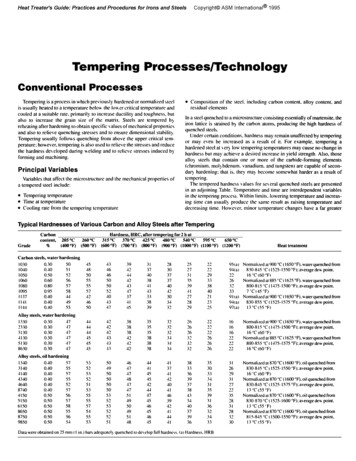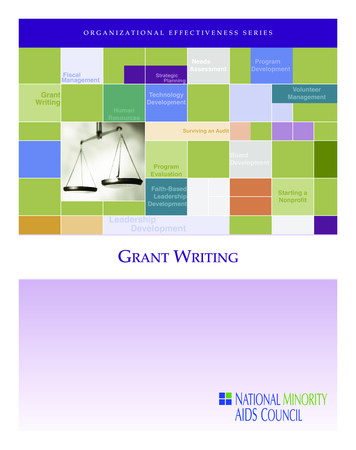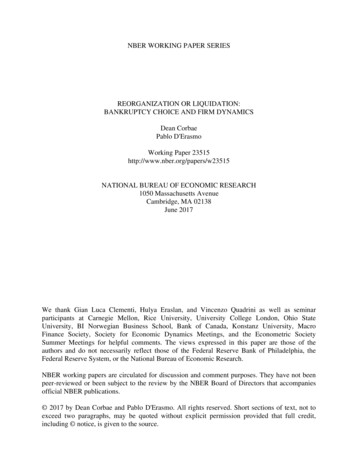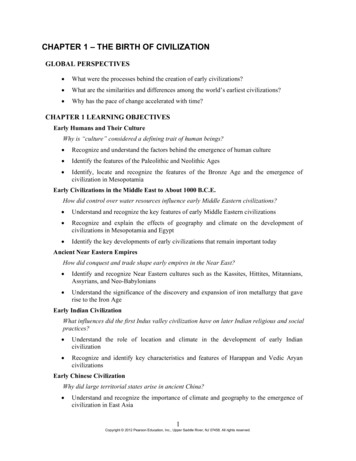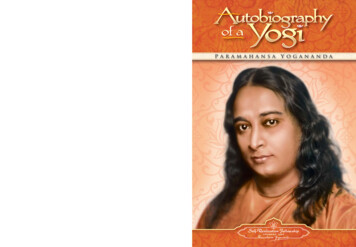
Transcription
The Complete Works ofPa r a m a h a n s a Yo g a n a n d aS e l f - R e a l i z at i on F e l l o w s h i pFOUNDED 1920 BY PARAMAHANSA YOGANANDAP ARA M AHANSAStart reading (or rereading) it today!”—YOGA JOYFUL LIVING“I keep stacks of Autobiography of aYogiaround the house, and I give it out constantly to people. When people need‘regrooving,’ I say read this, because itcuts to the heart of every religion.”—GEORGE HARRISON“Fascinating.”—NEWSWEEK“A rare account.”—THE NEW YORK TIMESISBN-13: 978-0-87612-083-5ISBN-10: 0-87612-083-4 12.50Y O G A N A N D AThis complete edition—available exclusively from Self-Realization Fellowship, theorganization founded by the author—is theonly one that incorporates all of his wishes forthe final text, including the extensive materialhe added after the original 1946 edition.“A life-changingbook.P A R A M A H A N S Aamed one of the 100 best spiritualbooks of the 20th century, ParamahansaYogananda’s remarkable life story takes you onan unforgettable exploration of the world ofsaints and yogis, science and miracles, deathand resurrection. With soul-satisfying wisdomand endearing wit, he illuminates the deepestsecrets of life and the universe—openingour hearts and minds to the joy, beauty, andunlimited spiritual potentials that exist in thelives of every human being.Y OGANANDA
CONTENTSList of Illustrations .ixPreface, by W. Y. Evans-Wentz . xiiiIntroduction. xvChapter1. My Parents and Early Life .32. My Mother’s Death and the Mystic Amulet . 133. The Saint With Two Bodies . 194. My Interrupted Flight Toward the Himalayas . 255. A “Perfume Saint” Displays His Wonders . 376. The Tiger Swami . 457. The Levitating Saint . 538. India’s Great Scientist, J. C. Bose . 589. The Blissful Devotee and His Cosmic Romance(Master Mahasaya). 6610. I Meet My Master, Sri Yukteswar . 7311. Two Penniless Boys in Brindaban. 8312. Years in My Master’s Hermitage . 9113. The Sleepless Saint . 11814. An Experience in Cosmic Consciousness . 12515. The Cauliflower Robbery . 13216. Outwitting the Stars . 14217. Sasi and the Three Sapphires . 15218. A Mohammedan Wonder-Worker . 15819. My Master, in Calcutta, Appears in Serampore. 16320. We Do Not Visit Kashmir . 16721. We Visit Kashmir . 17222. The Heart of a Stone Image . 18123. I Receive My University Degree. 18724. I Become a Monk of the Swami Order . 19425. Brother Ananta and Sister Nalini . 202vii
viiiAutobiography of a Yogi26. The Science of Kriya Yoga . 20727. Founding a Yoga School in Ranchi . 21628. Kashi, Reborn and Discovered . 22429. Rabindranath Tagore and I Compare Schools . 22930. The Law of Miracles . 23331. An Interview With the Sacred Mother(Kashi Moni Lahiri) . 24432. Rama Is Raised From the Dead . 25333. Babaji, Yogi-Christ of Modern India . 26134. Materializing a Palace in the Himalayas . 26935. The Christlike Life of Lahiri Mahasaya. 28136. Babaji’s Interest in the West . 29237. I Go to America . 30138. Luther Burbank — A Saint Amid the Roses. 30839. Therese Neumann, the Catholic Stigmatist . 31340. I Return to India . 32141. An Idyl in South India . 32842. Last Days With My Guru . 34043. The Resurrection of Sri Yukteswar . 35244. With Mahatma Gandhi at Wardha . 36945. The Bengali “Joy-Permeated Mother”(Ananda Moyi Ma). 38546. The Woman Yogi Who Never Eats. 39047. I Return to the West . 40048. At Encinitas in California . 40449. The Years 1940–1951 . 408Paramahansa Yogananda: A Yogi in Life and Death . 422Commemorative stamp issued by Government of Indiain honor of Paramahansa Yogananda . 423The Line of Self-Realization Fellowship Gurus . 431Aims and Ideals of Self-Realization Fellowship. 432Index . 433
CHAPTER 1My Parents and Early LifeThe characteristic features of Indian culture have long beena search for ultimate verities and the concomitant disciple-guru*relationship.My own path led to a Christlike sage; his beautiful life waschiseled for the ages. He was one of the great masters who areIndia’s truest wealth. Emerging in every generation, they have bulwarked their land against the fate of ancient Egypt and Babylonia.I find my earliest memories covering the anachronistic featuresof a previous incarnation. Clear recollections came to me of a distant life in which I had been a yogi† amid the Himalayan snows.These glimpses of the past, by some dimensionless link, also afforded me a glimpse of the future.I still remember the helpless humiliations of infancy. I wasresentfully conscious of being unable to walk and to express myself freely. Prayerful surges arose within me as I realized my bodilyimpotence. My strong emotional life was mentally expressed inwords of many languages. Amid the inward confusion of tongues, Igradually became accustomed to hearing the Bengali syllables of mypeople. The beguiling scope of an infant’s mind! adultly consideredto be limited to toys and toes.Psychological ferment and my unresponsive body brought meto many obstinate crying spells. I recall the general family bewilderment at my distress. Happier memories, too, crowd in on me:my mother’s caresses, and my first attempts at lisping phrase andtoddling step. These early triumphs, usually forgotten quickly, areyet a natural basis of self-confidence.My far-reaching memories are not unique. Many yogis areknown to have retained their self-consciousness without interruption by the dramatic transition to and from “life” and “death.” If* Spiritual teacher. The Guru Gita (verse 17) aptly describes the guru as “dispeller ofdarkness” (from gu, “darkness,” and ru, “that which dispels”).† Practitioner of yoga, “union,” ancient science of meditation on God. (See chapter26: “The Science of Kriya Yoga.”)3
4Autobiography of a Yogiman be solely a body, its loss indeed ends his identity. But if prophets down the millenniums spake with truth, man is essentially asoul, incorporeal and omnipresent.Although odd, clear memories of infancy are not extremelyrare. During travels in numerous lands, I have heard very early recollections from the lips of veracious men and women.I was born on January 5, 1893, in Gorakhpur in northeasternIndia near the Himalaya Mountains. There my first eight years werepassed. We were eight children: four boys and four girls. I, MukundaLal Ghosh,* was the second son and the fourth child.Father and Mother were Bengalis, of the Kshatriya caste.† Bothwere blessed with saintly nature. Their mutual love, tranquil and dignified, never expressed itself frivolously. A perfect parental harmonywas the calm center for the revolving tumult of eight young lives.Father, Bhagabati Charan Ghosh, was kind, grave, at timesstern. Loving him dearly, we children yet observed a certain reverential distance. An outstanding mathematician and logician, hewas guided principally by his intellect. But Mother was a queenof hearts, and taught us only through love. After her death, Fatherdisplayed more of his inner tenderness. I noticed then that his gazeoften seemed to be metamorphosed into my mother’s gaze.In Mother’s presence we children made an early bittersweetacquaintance with the scriptures. Mother would resourcefully summon from the Mahabharata and the Ramayana‡ suitable tales tomeet the exigencies of discipline; on these occasions chastisementand instruction went hand in hand.As a gesture of respect for Father, in the afternoons Motherwould dress us children carefully to welcome him home from the office. He held a position, similar to that of a vice-president, in one ofIndia’s large companies: Bengal-Nagpur Railway. His work involvedtraveling; our family lived in several cities during my childhood.Mother held an open hand toward the needy. Father was alsokindly disposed, but his respect for law and order extended to thebudget. One fortnight Mother spent, in feeding the poor, more thanFather’s monthly income.“All I ask, please,” Father said, “is that you keep your charities* My name was changed to Yogananda in 1915 when I entered the ancient monasticSwami Order. In 1935 my guru bestowed on me the further religious title ofParamahansa (see pp. 195 and 341).† The second caste, originally that of rulers and warriors.‡ These ancient epics are a hoard of India’s history, mythology, and philosophy.
My Parents and Early Life5within a reasonable limit.” Even a gentle rebuke from her husbandwas grievous to Mother. Not hinting to the children at any disagreement, she ordered a hackney carriage.“Good-bye, I am going away to my mother’s home.” Ancientultimatum!We broke into astounded lamentations. Our maternal unclearrived opportunely; he whispered to Father some sage counsel,garnered no doubt from the ages. After Father had made a few conciliatory remarks, Mother happily dismissed the cab. Thus endedthe only trouble I ever noticed between my parents. But I recall acharacteristic discussion.“Please give me ten rupees for a hapless woman who has justarrived at the house.” Mother’s smile had its own persuasion.“Why ten rupees? One is enough.” Father added a justification:“When my father and grandparents died suddenly, I had my firstexperience of poverty. My only breakfast, before walking miles tomy school, was a small banana. Later, at the university, I was insuch need that I applied to a wealthy judge for aid of one rupee permonth. He declined, remarking that even a rupee is important.”“How bitterly you recall the denial of that rupee!” Mother’sheart had an instant logic. “Do you want this woman also to remember painfully your refusal of ten rupees, which she needs urgently?”“You win!” With the immemorial gesture of vanquished husbands, he opened his wallet. “Here is a ten-rupee note. Give it toher with my goodwill.”Father tended first to say “No” to any new proposal. His attitude toward the stranger who so readily had won Mother’s sympathy was an example of his customary caution. An aversion toinstant acceptance is really only honoring the principle of “duereflection.” I always found Father reasonable and evenly balanced inhis judgments. If I could bolster up my numerous requests with oneor two good arguments, he would invariably put within my reachthe coveted goal — whether a vacation trip or a new motorcycle.Father was a strict disciplinarian to his children in their earlyyears, but his attitude toward himself was truly Spartan. He nevervisited the theater, for instance, but sought his recreation in variousspiritual practices and in reading the Bhagavad Gita.* Shunning all* This noble Sanskrit poem, which forms part of the Mahabharata epic, is the HinduBible. Mahatma Gandhi wrote: “Those who will meditate on the Gita will derivefresh joy and new meanings from it every day. There is not a single spiritual tanglewhich the Gita cannot unravel.”
6Autobiography of a Yogiluxuries, he would cling to one old pair of shoes until they wereuseless. His sons bought automobiles after they came into popularuse, but Father was content with the trolley car for his daily rideto the office.Father was not interested in the accumulation of money forthe sake of power. On one occasion, after he had organized theCalcutta Urban Bank, he refused to benefit himself by holding anyof its shares. He had simply wished to perform a civic duty in hisspare time.Several years after Father had retired on a pension, an accountant from England came to India to examine the books of BengalNagpur Railway. The amazed investigator discovered that Fatherhad never applied for overdue bonuses.“He did the work of three men!” the accountant told thecompany. “He has rupees 125,000 ( 41,250) owing to him as backcompensation.” The treasurer sent Father a check for that amount.My parent thought so little about the matter that he forgot to mention it to the family. Much later he was questioned by my youngest brother Bishnu, who had noticed the large deposit on a bankstatement.“Why be elated by material profit?” Father replied. “The onewho pursues a goal of evenmindedness is neither jubilant with gainnor depressed by loss. He knows that man arrives penniless in thisworld, and departs without a single rupee.”Early in their married life, my parents became disciples of agreat master, Lahiri Mahasaya of Banaras. This association strengthened Father’s naturally ascetical temperament. Mother once madea remarkable admission to my eldest sister Roma: “Your father andI sleep together as man and wife only once a year, for the purposeof having children.”Father met Lahiri Mahasaya through Abinash Babu,* an employee of a branch line of Bengal-Nagpur Railway. In Gorakhpur,Abinash Babu instructed my young ears with engrossing tales ofmany Indian saints. He invariably concluded with a tribute to thesuperior glories of his own guru.“Did you ever hear of the extraordinary circumstances underwhich your father became a disciple of Lahiri Mahasaya?” It was ona lazy summer afternoon, as Abinash and I sat together in the compound of my home, that he put this intriguing question. I shook myhead with a smile of anticipation.* Babu (Mister) is placed in Bengali names at the end.
My Parents and Early Life7“Years ago, before you were born, I asked my superior officer —your father — to give me a week’s leave from my office duties inorder to visit my guru in Banaras. Your father ridiculed my plan.“ ‘Are you going to become a religious fanatic?’ he inquired.‘Concentrate on your office work if you want to forge ahead.’“Sadly walking home along a woodland path that day, I metyour father in a palanquin. He dismissed his servants and conveyance, and fell into step beside me. Seeking to console me, hepointed out the advantages of striving for worldly success. But Iheard him listlessly. My heart was repeating: ‘Lahiri Mahasaya! Icannot live without seeing you!’“Our path took us to the edge of a tranquil field, where the raysof the late afternoon sun were crowning the tall ripple of the wildgrass. We paused in admiration. There in the field, only a few yardsfrom us, the form of my great guru suddenly appeared!*“‘Bhagabati, you are too hard on your employee!’ His voicewas resonant in our astounded ears. He vanished as mysteriouslyas he had come. On my knees I was exclaiming, ‘Lahiri Mahasaya!Lahiri Mahasaya!’ For a few moments your father was motionlesswith stupefaction.“‘Abinash, not only do I give you leave, but I give myself leaveto start for Banaras tomorrow. I must know this great Lahiri Mahasaya, who is able to materialize himself at will in order to intercedefor you! I will take my wife and ask this master to initiate us in hisspiritual path. Will you guide us to him?’“‘Of course.’ Joy filled me at the miraculous answer to myprayer, and the quick, favorable turn of events.“The next evening your parents and I entrained for Banaras.Reaching there on the following day, we took a horse cart for somedistance, then had to walk through narrow lanes to my guru’s secluded home. Entering his little parlor, we bowed before the master,enlocked in his habitual lotus posture. He blinked his piercing eyesand leveled them on your father. ‘Bhagabati, you are too hard onyour employee!’ His words were the same as those he had used twodays before in the grassy field. He added, ‘I am glad that you havepermitted Abinash to visit me, and that you and your wife haveaccompanied him.’“To their joy, he initiated your parents in the spiritual practice* The phenomenal powers possessed by great masters are explained in chapter 30,“The Law of Miracles.”
8Autobiography of a Yogiof Kriya Yoga.* Your father and I, as brother disciples, have beenclose friends since the memorable day of the vision. Lahiri Mahasaya took a definite interest in your own birth. Your life shall surelybe linked with his own; the master’s blessing never fails.”Lahiri Mahasaya left this world shortly after I had entered it.His picture, in an ornate frame, always graced our family altar inthe various cities to which Father was transferred by his office.Many a morning and evening found Mother and me meditatingbefore an improvised shrine, offering flowers dipped in fragrant sandalwood paste. With frankincense and myrrh as well as our uniteddevotions, we honored the divinity that had found full expressionin Lahiri Mahasaya.His picture had a surpassing influence over my life. As I grew,the thought of the master grew with me. In meditation I wouldoften see his photographic image emerge from its small frame and,taking a living form, sit before me. When I attempted to touchthe feet of his luminous body, it would change and again becomethe picture. As childhood slipped into boyhood, I found LahiriMahasaya transformed in my mind from a little image, cribbed ina frame, to a living, enlightening presence. I frequently prayed tohim in moments of trial or confusion, finding within me his solacing direction.At first I grieved because he was no longer physically living. AsI began to discover his secret omnipresence, I lamented no more. Hehad often written to those of his disciples who were over-anxious tosee him: “Why come to view my flesh and bones, when I am everwithin range of your kutastha (spiritual sight)?”At about the age of eight I was blessed with a wonderful healing through the photograph of Lahiri Mahasaya. This experiencegave intensification to my love. While at our family estate inIchapur, Bengal, I was stricken with Asiatic cholera. My life wasdespaired of; the doctors could do nothing. At my bedside, Motherfrantically motioned me to look at Lahiri Mahasaya’s picture on thewall above my head.“Bow to him mentally!” She knew I was too feeble even tolift my hands in salutation. “If you really show your devotion andinwardly kneel before him, your life will be spared!”* A yogic technique, taught by Lahiri Mahasaya, whereby the sensory tumultis stilled, permitting man to achieve an ever-increasing identity with cosmicconsciousness. (See chapter 26.)
My Parents and Early Life9I gazed at his photograph and saw there a blinding light, enveloping my body and the entire room. My nausea and other uncontrollable symptoms disappeared; I was well. At once I felt strongenough to bend over and touch Mother’s feet in appreciation of herimmeasurable faith in her guru. Mother pressed her head repeatedlyagainst the little picture.“O Omnipresent Master, I thank thee that thy light hath healedmy son!”I realized that she too had witnessed the luminous blaze throughwhich I had instantly recovered from a usually fatal disease.One of my most precious possessions is that same photograph.Given to Father by Lahiri Mahasaya himself, it carries a holy vibration. The picture had a miraculous origin. I heard the story fromFather’s brother disciple, Kali Kumar Roy.It appears that the master had an aversion to being photographed. Over his protest, a picture was once taken of him and agroup of devotees, including Kali Kumar Roy. It was an amazedphotographer who discovered that the plate, which had clear images of all the disciples, revealed nothing more than a blank spacein the center where he had reasonably expected to find the outlinesof Lahiri Mahasaya. The phenomenon was widely discussed.A student who was an expert photographer, Ganga Dhar Babu,boasted that the fugitive figure would not escape him. The nextmorning, as the guru sat in lotus posture on a wooden bench witha screen behind him, Ganga Dhar Babu arrived with his equipment.Taking every precaution for success, he greedily exposed twelveplates. On each one he soon found the imprint of the wooden benchand screen, but once again the master’s form was missing.With tears and shattered pride, Ganga Dhar Babu sought out hisguru. It was many hours before Lahiri Mahasaya broke his silencewith a pregnant comment:“I am Spirit. Can your camera reflect the omnipresent Invisible?”“I see it cannot! But, Holy Sir, I lovingly desire a picture ofyour bodily temple. My vision has been narrow; until today I didnot realize that in you the Spirit fully dwells.”“Come, then, tomorrow morning. I will pose for you.”Again the photographer focused his camera. This time thesacred figure, not cloaked with mysterious imperceptibility, wassharp on the plate. The master never posed for another picture; atleast, I have seen none.
10Autobiography of a YogiThe photograph is reproduced in this book.* Lahiri Mahasaya’sfair features, of a universal cast, hardly suggest to what race he belonged. The joy of God-communion is slightly revealed in his enigmatic smile. His eyes, half open to denote a nominal interest in theouter world, are also half closed, indicating his absorption in innerbliss. Oblivious of the poor lures of the earth, he was fully awakeat all times to the spiritual problems of seekers who approachedfor his bounty.Shortly after my healing through the potency of the guru’spicture, I had an influential spiritual vision. Sitting on my bed onemorning, I fell into a deep reverie.“What is behind the darkness of closed eyes?” This probingthought came powerfully into my mind. An immense flash oflight at once manifested to my inner gaze. Divine shapes of saints,sitting in meditation posture in mountain caves, formed like miniature cinema pictures on the large screen of radiance within myforehead.“Who are you?” I spoke aloud.“We are the Himalayan yogis.” The celestial response is difficult to describe; my heart was thrilled.“Ah, I long to go to the Himalayas and become like you!” Thevision vanished, but the silvery beams expanded in ever-wideningcircles to infinity.“What is this wondrous glow?”“I am Ishwara.† I am Light.” The Voice was as murmuringclouds.“I want to be one with Thee!”Out of the slow dwindling of my divine ecstasy, I salvaged apermanent legacy of inspiration to seek God. “He is eternal, evernew Joy!” This memory persisted long after the day of rapture.Another early recollection is outstanding; and literally so, for Ibear the scar to this day. My elder sister Uma and I were seated in the* Opposite page 273. Copies of the photograph are available from Self-RealizationFellowship. See also painting of Lahiri Mahasaya opposite page 304. While in Indiain 1935–36, Sri Paramahansa Yogananda instructed a Bengali artist to paint thisrendering of the original photograph, and later designated it as the formal portrait ofLahiri Mahasaya for use in SRF publications. (This painting hangs in ParamahansaYogananda’s sitting room at Mt. Washington.) (Publisher’s Note)† A Sanskrit name for the Lord in His aspect of Cosmic Ruler; from the root is, torule. The Hindu scriptures contain a thousand names for God, each one carrying adifferent shade of philosophical meaning. The Lord as Ishwara is He by whose willall universes, in orderly cycles, are created and dissolved.
My Parents and Early Life11early morning under a neem tree in our Gorakhpur compound. Shewas helping me in my study of a Bengali primer, what time I couldspare my gaze from the nearby parrots eating ripe margosa fruit.Uma complained of a boil on her leg, and fetched a jar of ointment. I smeared a bit of the salve on my forearm.“Why do you use medicine on a healthy arm?”“Well, Sis, I feel I am going to have a boil tomorrow. I am testing your ointment on the spot where the boil will appear.”“You little liar!”“Sis, don’t call me a liar until you see what happens in themorning.” Indignation filled me.Uma, unimpressed, thrice repeated her taunt. An adamantresolution sounded in my voice as I made slow reply.“By the power of will in me, I say that tomorrow I shall have afairly large boil in this exact place on my arm; and your boil shallswell to twice its present size!”Morning found me with a stalwart boil on the indicated spot;the dimensions of Uma’s boil had doubled. With a shriek, my sisterrushed to Mother. “Mukunda has become a necromancer!” Gravely,Mother instructed me never to use the power of words for doingharm. I have always remembered her counsel, and followed it.My boil was surgically treated. A noticeable scar, left by thedoctor’s incision, is present today. On my right forearm is a constant reminder of the power in man’s sheer word.Those simple and apparently harmless phrases to Uma, spoken with deep concentration, had possessed sufficient hidden forceto explode like bombs and to produce definite, though injurious,effects. I understood later that the explosive vibratory power inspeech could be wisely directed to free one’s life from difficultiesand thus operate without scar or rebuke.*Our family moved to Lahore in the Punjab. There I acquireda picture of the Divine Mother in the form of the Goddess Kali.†It sanctified a small informal shrine on the balcony of our home.An unequivocal conviction came over me that fulfillment wouldcrown any of my prayers uttered in that sacred spot. Standing therewith Uma one day, I watched two boys flying kites over the roofs of* The infinite potencies of sound derive from the Creative Word, Aum, the cosmicvibratory power behind all atomic energies. Any word spoken with clear realizationand deep concentration has a materializing value. Loud or silent repetition of inspiringwords has been found effective in Couéism and similar systems of psychotherapy; thesecret lies in the stepping-up of the mind’s vibratory rate.† Kali is a symbol of God in the aspect of eternal Mother Nature.
12Autobiography of a Yogitwo buildings that were separated from our house by an extremelynarrow lane.“Why are you so quiet?” Uma pushed me playfully.“I am just thinking how wonderful it is that Divine Mothergives me whatever I ask.”“I suppose She would give you those two kites!” My sisterlaughed derisively.“Why not?” I began silent prayers for their possession.Matches are played in India with kites whose strings are covered with glue and ground glass. Each player attempts to sever thestring held by his opponent. A freed kite sails over the roofs; thereis great fun in catching it. As Uma and I were on a roofed, recessedbalcony, it seemed impossible that a loosed kite could come intoour hands; its string would naturally dangle over the roof.The players across the lane began their match. One stringwas cut; immediately the kite floated in my direction. Owing to asudden abatement of the breeze the kite remained stationary for amoment, during which its string became firmly entangled with acactus plant on top of the opposite house. A long, perfect loop wasformed for my seizure. I handed the prize to Uma.“It was just an extraordinary accident, and not an answer toyour prayer. If the other kite comes to you, then I shall believe.”Sister’s dark eyes conveyed more amazement than her words. Icontinued my prayers with intensity. A forcible tug by the otherplayer resulted in the abrupt loss of his kite. It headed toward me,dancing in the wind. My helpful assistant, the cactus plant, againsecured the kite string in the necessary loop by which I could graspit. I presented my second trophy to Uma.“Indeed, Divine Mother listens to you! This is all too uncannyfor me!” Sister bolted away like a frightened fawn.
The Complete Works ofPa r a m a h a n s a Yo g a n a n d aS e l f - R e a l i z at i on F e l l o w s h i pFOUNDED 1920 BY PARAMAHANSA YOGANANDAP ARA M AHANSAStart reading (or rereading) it today!”—YOGA JOYFUL LIVING“I keep stacks of Autobiography of aYogiaround the hous
books of the 20th century, Paramahansa Yogananda’s remarkable life story takes you on an unforgettable exploration of the world of saints and yogis, science and miracles, death and resurrection. With soul-satisfying wisdom and endearing wit, he illumin

